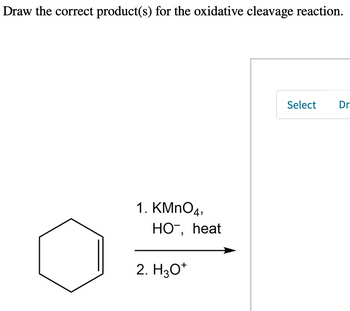
Organic Chemistry: A Guided Inquiry
2nd Edition
ISBN: 9780618974122
Author: Andrei Straumanis
Publisher: Cengage Learning
expand_more
expand_more
format_list_bulleted
Question
HELP NOW PLEASE ! ASAP! URGENT!

Transcribed Image Text:Draw the correct product(s) for the oxidative cleavage reaction.
1. KMnO4,
HO-, heat
2. H3O+
Select
Dr.
Expert Solution
This question has been solved!
Explore an expertly crafted, step-by-step solution for a thorough understanding of key concepts.
Step by stepSolved in 2 steps with 2 images

Knowledge Booster
Similar questions
- In Part 1 add the curved arrows to the nucleophilic acyl substitution reaction mechanism. In Part 2, answer the multiple-choice question about the reaction in Part 1. Part 1 See Periodic Table O See Hint :ö: :Br: Add the missing curved arrow notation. 20 F CI Br I Part 2 Which statement is most correct regarding the equilibrium for the above reaction? Choose one: O The equilibrium favors the right (i.e., Kea > 1) because acetate is a better leaving group than bromide. O The equilibrium favors the right (i.e., Keg > 1) because bromide is a better leaving group than acetate. O The equilibrium favors the left (i.e. Keg « 1) because acetate is a better leaving group than bromide. O The equilibrium favors the left (i.e., Keg« 1) because bromide is a better leaving group than acetate.arrow_forwardI need the reaction mechanism of this steparrow_forwardPlease explain why this reaction will NOT WORK. NO2 1. HNO3, H2SO4, 2. EtCI, AICI3arrow_forward
- 27. Draw a circle around the compound that reacts most rapidly with NaN3 in DMSO and draw a rectangle around the molecule that reacts most slowly with NaN3 in DMSO. Br Br Br 28. Draw a circle around the compound that reacts most rapidly with NaOAc in HOAC and draw a rectangle around the molecule that reacts most slowly with NaOAc in HOAC. Br Br Br ***||arrow_forward12. Draw in the curved arrows for the first step of an SN1 mechanism. X 13. Fill in the box with the major organic product of the second step of an SN1 mechanism. OH 14. Draw in the curved arrows for the first step of an E1 mechanism. le Br H 15. Fill in the box with the major organic product of the second step of an E1 mechanism. -H* ·arrow_forwardHi, 40) The rate of a particular reaction doubles when the termperature increases from 25oC to 35oC. Explain why this happens. Thanks,arrow_forward
- Draw the SN2 mechanism.arrow_forwardFor the given SN2 reaction, draw the organic and inorganic products of the reaction, and identify the nucleophile, substrate, and leaving group. Include wedge-and-dash bonds and draw hydrogen on a stereocenter. Н..... C=N Organic product Inorganic product CI Draw the organic product. Erase Select Draw Rings More |||| с H N Cl Erase Draw the inorganic product. Select Draw Rings More /// с H N Clarrow_forward5. Propose an arrow mechanism. EtO OEt 1. NaOEt 2. ICH₂CH₂CH₂ 3. H₂O+ HOarrow_forward
- 11. Draw the mechanism and final product. Br-Brarrow_forward027 In Part 1 add the curved arrows to the nucleophilic acyl substitution reaction mechanism. In Part 2, answer the multiple-choice question about the reaction in Part 1. Part 1 4 See Periodic Table O See Hint :0: :Br: Add the missing curved arrow notation. S CI Br Part 2 Which statement is most correct regarding the equilibrium for the above reaction? Choose one: O The equilibrium favors the right (i.e., Kea > 1) because acetate is a better leaving group than bromide. O The equilibrium favors the right (i.e., Kea > 1) because bromide is a better leaving group than acetate. O The equilibrium favors the left (i.e., Keq« 1) because acetate is a better leaving group than bromide. O The equilibrium favors the left (i.e., Keg 1) because bromide is a better leaving group than acetate. +arrow_forward:Draw two major products :Reaction type for the major product :Draw one minor product :Reaction type for the minor productarrow_forward
arrow_back_ios
SEE MORE QUESTIONS
arrow_forward_ios
Recommended textbooks for you
 Organic Chemistry: A Guided InquiryChemistryISBN:9780618974122Author:Andrei StraumanisPublisher:Cengage Learning
Organic Chemistry: A Guided InquiryChemistryISBN:9780618974122Author:Andrei StraumanisPublisher:Cengage Learning

Organic Chemistry: A Guided Inquiry
Chemistry
ISBN:9780618974122
Author:Andrei Straumanis
Publisher:Cengage Learning